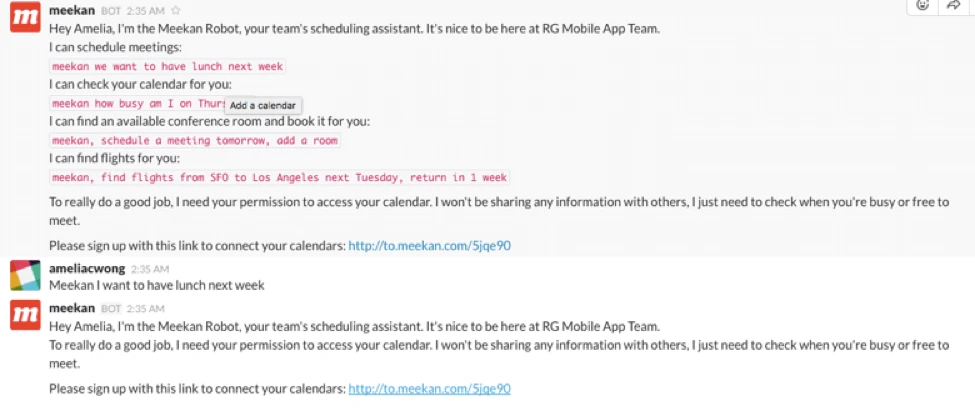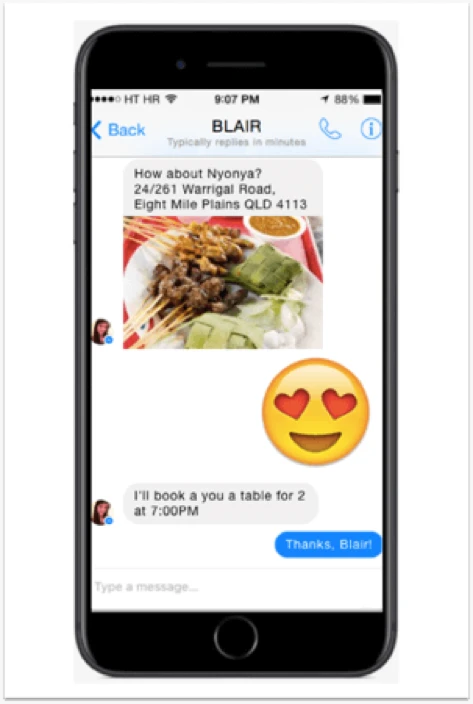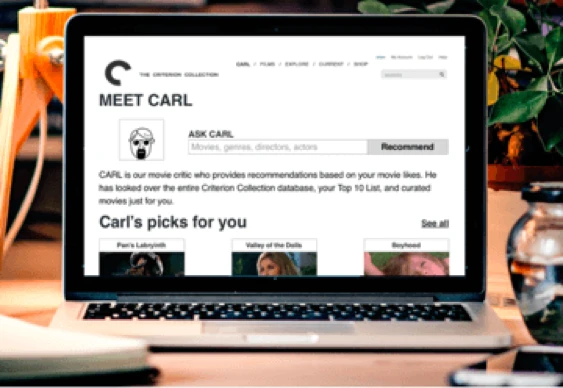
Considering that Microsoft, Facebook, Google, and Samsung have released their own Chatbots and have demonstrated the importance of artificial intelligence on the web, 2016 was the year of Chatbots.
What is a Chatbot and what can it be used for? A Chatbot is a service that operates within a set of predefined rules, taking into account user interactions in a chat environment. This service can be used as a product that is useful in many areas, from filling out forms to performing functions.
Practical Uses of Chatbots
Scheduling
For users working with a scheduling system, creating a weekly plan is one of the biggest tortures. A chatbot, coordinated with a human or bot, can automate the creation of the calendar system. After coordination, the bot can send the weekly plan to the user. Additionally, if the user specifies times they do not want to be scheduled, the bot can make adjustments for suitable time slots.
An example of a scheduling bot is Meekan. Meekan, available on Slack or in a browser, is an ideal digital assistant that can create lunch appointments, arrange meeting rooms, or find flights.

Welcoming and Onboarding
When users first enter a website or application, they adapt to the system more quickly through chatbots. They provide a better user experience with quick responses and being 'there'. Being embedded in the application or website, they reduce the users' need for customer support.

Dolores Landingham is a bot on Slack for 18F, welcoming new employees. With Dolores, new employees minimize the time spent on one-on-one training or reading documentation.
Engaging Users on the Website
Since Chatbots are within a platform, they can track user behaviors. They can recommend similar sites or social networks based on their interests.

Blair is a voice-integrated bot serving in Singapore. The bot, designed for Facebook Messenger, aims to recommend different restaurants and make reservations.
Advertising
The advancement of Chatbots positively affects advertising. They can identify users' shopping habits and recommend products they might like.

Spring, a shopping startup, is a virtual assistant available 24/7 for users.
Motivation
People need support while trying to achieve their set goals. Although friends often try to motivate each other, they may not always want to share everything with the other party.
Chatbots can motivate users with personalized notifications. These messages, sent regularly with reminders and compatible with the person's character, support users' motivation.

Opal, a prototype on BOTTR, accepts certain responses as templates and serves according to patterns that match these templates. Although it provides general motivation, it may not be sufficient to support a person's goals due to its one-dimensional nature.
Chatbot Experience Essentials
Personalization Ambiguity
Chatbots should address users by name and provide answers they want to know instead of asking generic questions. They should be able to recognize and respond to personalized questions and answers.
Eliza, MIT's Chatbot, made this issue apparent in 1964. Eliza, acting as a psychotherapist, asked users standard questions and fitted their responses into patterns. If the user gave an undefined response, the bot would crash.

The problem with Eliza still persists today. Opal, responding only to defined answers, falls short when asked complex questions about motivation. Although it meets the demand to make users happy, it fails to motivate them towards their goals.
Increased personalization in bots also brings better user experiences. Blair, in addition to offering restaurant recommendations and reservations, will eventually understand and meet other user needs. Similarly, Spring will be able to analyze users' preferences better and serve as a personalized shopping assistant.
Bots can also help achieve corporate goals. Dolores Landingham, being a bot for new employees, plays a significant role in facilitating human resources and documentation processes. In the future, it will hold an important place in achieving corporate goals with features that increase employee productivity and save time.
Solution: Personalization Through Dialogue
Personalizing a Chatbot requires a dialogue-based flow. Scenarios should be drawn or language should be mapped in dialogue-based flow. Responses should be created considering interactions and language structure.

Mapping language means analyzing dialogues by breaking them down into sentences and words. The most common method used is the analysis of syntax.
With the analysis of syntax, different responses can be generated for a statement, and different meanings can be inferred. Multiple responses can be created if desired, focus can be on the adopted expression, or a general response can be given.

Syntax maps are quite useful for Chatbot usage. They allow for predictable responses and provide alternatives when the user deviates from the scenario. Although predicting user-caused errors is difficult, chatbots redirect users back to the scenario by providing alternative responses.
Loss of Engagement
One of the most important things in the Chatbot experience is maintaining attention. Once the user's attention and interest are lost, bots become useless. Maintaining engagement throughout the experience is essential.
Meekan is an example of a bot that experiences loss of engagement. It requires user approval to make changes to the calendar, which redirects the user outside of Slack and distracts their attention.
Another bot that faces engagement problems is Opal. When it fails to answer your complex questions, it loses your interest, and you might close the page thinking it's useless.
Solution: Enhance Engagement with Visuals
Designers should make Chatbots visually appealing while also conveying that they are robots. Users generally feel uncomfortable with the use of human figures in bot images, preferring illustrations instead.

Users associate Chatbots with familiar humans or users. They have bot characters imposed on them and created in their minds. According to a study on a Chatbot named 'Coach' controlled by a human and more specifically a woman, female users imagined it as a strong, male character. Even if unintentionally, people tend to see bots not as machines but as humans.
The Future Potential of Chatbots
Chatbots have the potential to create better user experiences. They are fast, always responsive, and always available. Today, they are used as digital assistants, enabling people to benefit from services like cleaning and dry cleaning without needing an additional service.
As technology advances, Chatbots will become highly personalized, evolving from assistants to services that greatly benefit people's lives at minimal cost.
“Writing is seeing the future.” Paul Valéry

